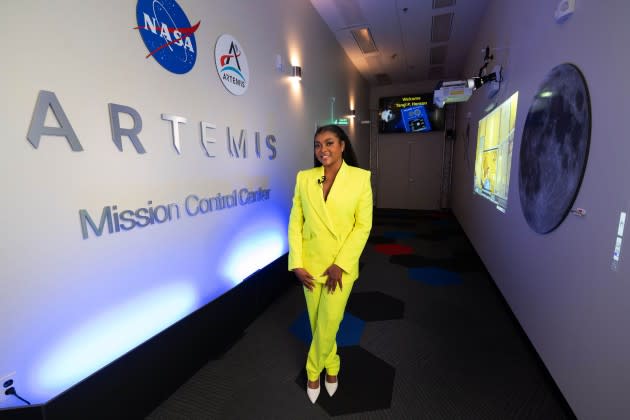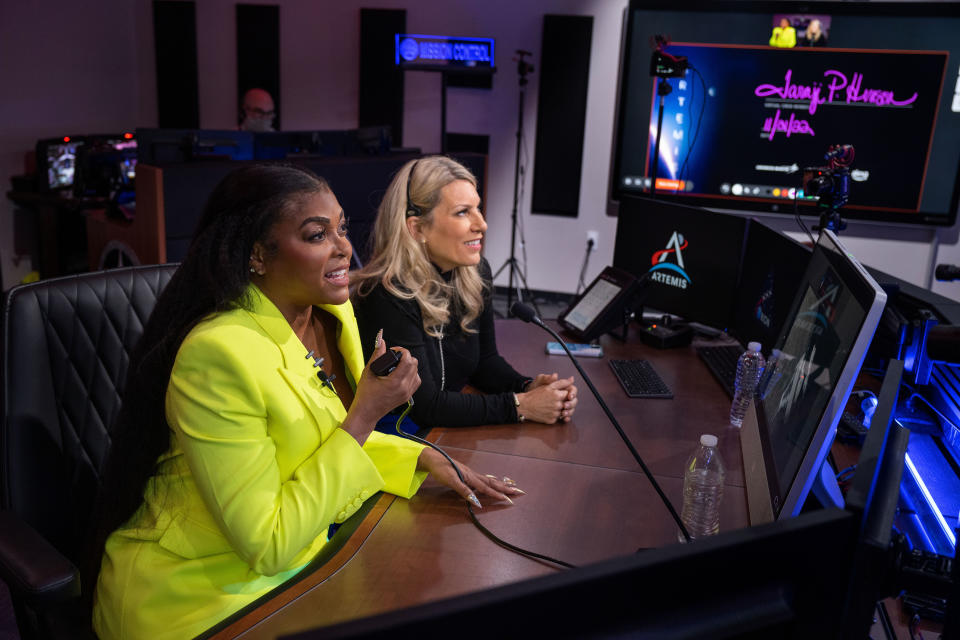Taraji P. Henson On Chatting With Alexa In Space, and Inspiring the Next Generation of Astronauts
- Oops!Something went wrong.Please try again later.

If you purchase an independently reviewed product or service through a link on our website, Rolling Stone may receive an affiliate commission.
“Alexa, how far from Earth are you?” A pause, and the voice assistant responds. “Currently, Orion is 217,362 miles away from Earth, and 12,711 miles away from the Moon.” With a view from one of the astronauts’ seats, Taraji P. Henson, currently sitting in the Callisto Operation Suite at NASA that exact number of miles away on Earth, light ups. “Alexa, set the lights to party mode.”
More from Rolling Stone
Gift Guide: This is the Best Gear We're Shopping at Adidas this Holiday Season
If You've Got a Small Business, You're Going to Need This Top-Rated Accounting Software
Holiday Road: These Are Our Favorite Hacks and Gadgets to Make Your Road Trip Run More Smoothly
Henson has teamed up Amazon and Alexa as part of Artemis I, the first of several NASA missions with the intention of landing the first woman and the first person of color on the Moon. Artemis I marks the beginning of a new era in deep space exploration, and Henson’s goal is to help inspire the next generation of scientists, engineers and astronauts. Up in space, Alexa has been integrated directly into the Orion spacecraft (inspired by the Star Trek computer, no less) to help NASA test how AI and voice technology can assist astronauts during future missions to the Moon and beyond.

Amazon Alexa Devices
Henson says that she definitely became more interested and inquisitive about what was going on in space after portraying Catherine Johnson in the film Hidden Figures. “When I was growing up—no one ever said it to me, but it was understood—that math and science were only for boys,” Henson said in an interview with Kelly Wenzel from Amazon. “So I literally would disappear in those classes because it wasn’t for me. I had no interest.” She says that perhaps if there had been more women and people of color in the field, perhaps she would have dreamed of being an astronaut, or fallen in love with STEM. “If you see it, you believe it, and you can achieve it.”
She says that anyone behind in the scenes in STEM industries should look like what the world looks like, and that it’s important to show students, but also parents and teachers, how we can push the limits of technology and AI for good.
Henson sat down with Rolling Stone to talk chatting with Alexa up in space, representation in space-themed media, and why we keep going back to the moon.
Why did you feel like now was the right time to partner with Amazon and Alexa as part of Artemis I?
I was inspired by a movie I did called Hidden Figures. I know how impactful that movie was for little girls and girls of color. I never saw such representation growing up which is why I didn’t get in to math or science. Times have changed for the better. Maybe I would have gotten into STEM or space as a young kid if I had someone who looked like me in those positions. With the launch of Artemis I, it’s a big first step to eventually land the first woman and the first person of color on the Moon – and I’m excited to play a small part in telling people about that.
What was it like interacting with Alexa in space?
It was very cool, the mission is crewless but since Alexa is in space, you can see how voice recognition and AI can help with future missions. I asked, “Alexa, how much oxygen is on board,” “Alexa, how far from Earth are you?” and “Alexa, how fast is Orion going?” At home, you can walk right over to Alexa to learn more by saying, “Alexa, take me to the Moon.”
Artemis I is just the first of many NASA missions aimed at landing the first woman and first person of color on the moon. Why do you think it’s still important that we keep going back to the moon, even if we’re aiming beyond the stars (i.e. landing humans on Mars)?
We have to gather information to see where we’re going next, it’s important for our human existence. While I might not want to go to space anytime soon, I am interested in the future and to understand what’s in store for us.
How do you think engineers are defining this next era of space exploration? Why do you think it’s important that we push the limits of technology and AI to inspire future scientists, astronauts, etc?
Inspiring the next generation is so important. We should provide them with as much hands-on STEM experience they can have. I didn’t have that growing up but now, through advanced technology and AI capabilities, I can’t imagine kids not being inspired about Alexa and going over to say, “Alexa, take me to the moon.” The technology and information to learn and inspire is right at our fingertips.
Representation is so important — do you think we’re living in a new era for women in space on-screen as opposed to off? Are there any pieces of sci-fi that you think are particularly killing it in this regard?
There has absolutely been a difference in representation in women in space movies; I never saw such representation growing up on screen or off, which is why I didn’t get into math or science. Times have changed for the better. Maybe I would have gotten into STEM or space as a young kid if I had someone who looked like me on-screen.
Culturally, why is it we’re still obsessed with space? Not just in exploration, but in aesthetics too — just recently you had your own “space age” look at the Rhianna x Fenty Amazon.
There is so much to explore in space. We’ve gone farther on this trip than we ever have gone before so if we keep pushing you never know! Originally, the look was supposed to be like a serpent. When we had everything connected through my braids and my team and hair stylist Tym Wallace decided to expand a bit. We went with the notches on my head and it gave everything more of a space-age look.
What can we expect from some of your own upcoming projects?
I’m working on a musical version of The Color Purple, and I can’t wait to share it with everyone.
Best of Rolling Stone
Click here to see more up-to-date holiday deals!

